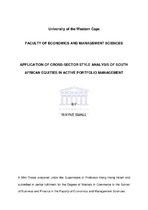| dc.contributor.advisor | Hsieh, Heng-Hsing | |
| dc.contributor.author | Small, Wayne | |
| dc.date.accessioned | 2016-04-07T11:09:44Z | |
| dc.date.available | 2016-04-07T11:09:44Z | |
| dc.date.issued | 2015 | |
| dc.identifier.uri | http://hdl.handle.net/11394/4879 | |
| dc.description | Magister Commercii - MCom | en_US |
| dc.description.abstract | A distinctive phenomenon on the JSE Securities Exchange (JSE) is the market
segmentation between the resource sector and the financial and industrial sectors.
Criticisms also arise from employing a capitalization-weighted (cap-weighted) index
such as the ALSI index when the market is less than perfectly efficient. A study
conducted by Vardharah and Fabozzi (2007) also suggests that a correlation exists
between sector allocation decisions and the investment styles inherent in portfolios. The uniqueness of the South African stock market is that it is dominated by three major sectors, namely, the financial sector, the industrial sector and the resources sector. The goal of this research is to examine the application of sector influences on the JSE over the examination period 1 January 2003 to 31 December 2013. It is the contention that the cap-weighted ALSI index is price-sensitive and potentially
mean-variance inefficient. The study therefore attempts to evaluate the relative meanvariance efficiency of alternative sector allocation strategies versus the cap-weighted ALSI as the optimal risky portfolio on the JSE. Two optimal long-only portfolios that maximises the Sharpe ratio are constructed and compared to the market proxy on the JSE over the examination period from 1 January 2003 to 31 December 2013. A longonly portfolio that comprises the JSE tradable sector indices and includes a cash allocation (risk-free proxy) and a long-only portfolio exclusive of the cash allocation are constructed. The research extends to cross-examine the inter-relationship between sector returns and the investment styles on the JSE using the Carhart (1997) four-factor model. The research further reexamines and updates the market segmentation phenomenon over the extended examination period from 1 January 2003 to 31 December 2013. The practicality of two sector-based multifactor APT models are examined and compared to the single-factor CAPM to determine which of the asset pricing models better explain JSE equity returns. A sector-based two-factor APT model proposed by Van Rensburg (2002) using the JSE sector indices FNDI and RESI as the sector proxies is reexamined and a sector-based three-factor APT model using the JSE tradable sector indices FINI, INDI and RESI as the sector proxies is explored. The optimal long-only portfolio with the cash allocation is found to offer the best meanvariance
efficient allocation and the ALSI index represents the most mean-variance
inefficient portfolio. The resource sector is found to be the worst performing sector and significantly influences the performance of ALSI. In terms of the style risk influences, the financial sector has a strong value bias and the industrial sector has a moderate value bias, small cap bias and a momentum bias. The resource sector, for the most part, is influenced by growth stocks and has a contrarian tilt. It is also found that the market segmentation phenomenon continues to exist on the JSE. Although the explanatory power of the three-factor APT model and the two-factor APT model is similar, the distinct advantage of the three-factor APT model is that systematic risks could be observed more closely by separating FINI and INDI in the asset pricing model. | en_US |
| dc.language.iso | en | en_US |
| dc.publisher | University of the Western Cape | en_US |
| dc.subject | Market segmentation | en_US |
| dc.subject | Asset pricing models | en_US |
| dc.subject | Financial sector | en_US |
| dc.subject | JSE Securities Exchange (JSE) | en_US |
| dc.title | Application of cross-sector style analysis of South African equities in active portfolio management | en_US |
| dc.rights.holder | University of the Western Cape | en_US |

